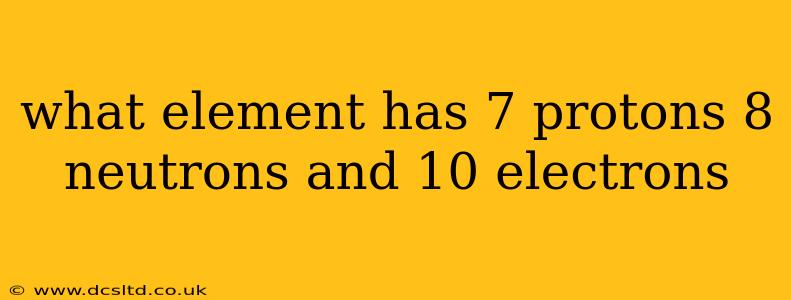What Element Has 7 Protons, 8 Neutrons, and 10 Electrons?
This question delves into the fundamental building blocks of matter and the relationship between protons, neutrons, and electrons. Let's break it down to understand the answer.
Understanding Atomic Structure:
An atom is composed of three subatomic particles:
- Protons: Positively charged particles found in the atom's nucleus. The number of protons defines the element.
- Neutrons: Neutrally charged particles also residing in the nucleus. They contribute to the atom's mass but not its charge.
- Electrons: Negatively charged particles orbiting the nucleus in electron shells. The number of electrons typically equals the number of protons in a neutral atom.
Identifying the Element:
The question states we have an atom with 7 protons. The atomic number of an element is equal to the number of protons. Consulting the periodic table, we find that the element with atomic number 7 is nitrogen (N).
Addressing the Discrepancy:
The fact that this atom possesses 10 electrons, rather than the usual 7 that would balance the 7 protons, indicates that this nitrogen atom is an ion. Specifically, it's a nitrogen anion with a 3- charge (N³⁻). It has gained three extra electrons.
Therefore, the answer is a nitrogen ion (N³⁻).
What are ions?
Ions are atoms or molecules that have gained or lost one or more electrons, resulting in a net electrical charge. When an atom gains electrons, it becomes a negatively charged ion (anion). When it loses electrons, it becomes a positively charged ion (cation).
How are ions formed?
Ions are typically formed through chemical reactions where atoms transfer electrons to achieve a stable electron configuration. This often involves the interaction of elements with significantly different electronegativities.
What are some examples of ions?
Many common substances are made up of ions. For example, table salt (sodium chloride, NaCl) is composed of sodium cations (Na⁺) and chloride anions (Cl⁻). Similarly, many minerals and electrolytes in the human body exist as ions.
How many electrons does a neutral nitrogen atom have?
A neutral nitrogen atom has 7 electrons, matching the number of protons in its nucleus to ensure an electrically neutral overall charge.
What is the mass number of this nitrogen ion?
The mass number of an atom is the sum of its protons and neutrons. In this case, the mass number is 7 (protons) + 8 (neutrons) = 15. Therefore, the nitrogen ion is denoted as ¹⁵N³⁻. Note that the mass number doesn't change whether the atom is an ion or not.
In summary, while the number of protons defines the element as nitrogen, the presence of 10 electrons clarifies that it's a negatively charged nitrogen ion (N³⁻) with a mass number of 15. Understanding the basic principles of atomic structure is crucial for interpreting these details.
